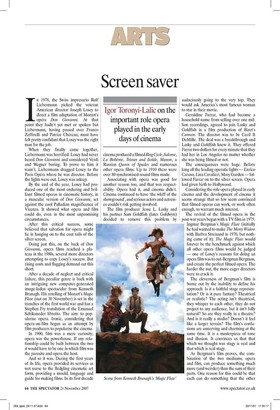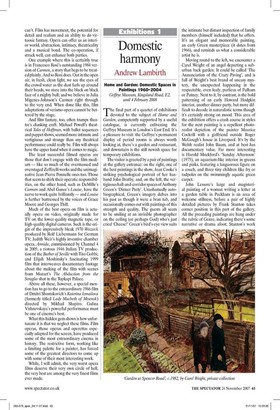Screen saver
Igor Toronyi-Lalic on the important role opera played in the early days of cinema Jn 1978, the Swiss impresario Rolf Liebermann picked the veteran American director Joseph Losey to direct a film adaptation of Mozart's opera Don Giovanni. At that point they hadn't yet met or spoken but Liebermann, having passed over Franco Zeffirelli and Patrice Chereau, must have felt pretty confidant that Losey was the right man for the job.
When they finally came together, Liebermann was horrified. Losey had never heard Don Giovanni and considered Verdi and Wagner boring. To prove to him it wasn't, Liebermann dragged Losey to the Paris Opera where he was director. Before the lights were out, Losey was asleep.
By the end of the year, Losey had produced one of the most enduring and brilliant filmed operas in cinematic history, in a muscular version of Don Giovanni, set against the cool Palladian magnificence of Vicenza. It showed what opera and film could do, even in the most unpromising circumstances.
After this critical success, some believed that salvation for opera might lie in hanging on to the coat tails of the silver screen.
Doing just this, on the back of Don Giovanni, opera films reached a plateau in the 1980s, several more directors attempting to copy Losey's success. But rising costs and flagging demand cut this short.
After a decade of neglect and critical failure, this peculiar genre is back with an intriguing new computer-generated image-laden spectacular from Kenneth Branagh. His retelling of Mozart's Magic Flute (out on 30 November) is set in the trenches of the first world war and has a Stephen Fry translation of the Emanuel Schikaneder libretto. The aim: to popularise opera. Ironic, considering that opera-on-film began as an attempt by film producers to popularise the cinema.
In 1900, film was a mere curiosity; opera was the powerhouse. If any relationship could be built between the two it would have to be one in which film was the parasite and opera the host.
And so it was. During the first years of its life, opera provided its services as wet nurse to the fledgling cinematic art form, providing a mould, language and guide for making films. In its first decade cinema produced a filmed Ring Cycle, Salome, La Boheme, Tristan and Isolde, Manon, a Russian Queen of Spades and numerous other opera films. Up to 1910 there were over 80 synchronised-sound films made.
Associating with opera was good for another reason too, and that was respectability. Opera had it, and cinema didn't. Cinema continued to have `the whiff of the showground', and serious actors and actresses couldn't risk getting involved.
The film producer Jesse L. Lasky and his partner Sam Goldfish (later Goldwyn) decided to remove this problem by audaciously going to the very top. They would ask America's most famous woman to star in their movie.
Geraldine Farrar, who had become a household name from selling over one million recordings, agreed to join Lasky and Goldfish in a film production of Bizet's Carmen. The director was to be Cecil B DeMille. The deal was a breakthrough and Lasky and Goldfish knew it. They offered Farrar two dollars for every minute that they had her in Los Angeles no matter whether she was being filmed or not.
The consequences were huge. Before long all the leading operatic lights — Enrico Caruso, Lina Cavalieri, Mary Garden — followed Farrar on to the silver screen. Opera had given birth to Hollywood.
Considering the role opera played in early cinema and the development of cinema it seems strange that so few seem convinced that filmed operas can work, or work often enough, to warrant much interest.
The revival of the filmed opera in the post-war years began with a TV film in 1975: Ingmar Bergman's Magic Flute (initially he had wanted to make The Merry Widow with Barbra Streisand in 1970, but nothing came of it). The Magic Flute would forever be the benchmark against which all other opera films would be judged — one of Losey's reasons for doing an opera film was to out-Bergman Bergman, and create the perfect filmed opera. The harder the nut, the more eager directors were to crack it.
The cleverness of Bergman's film is borne out by the inability to define his approach. Is it a faithful stage representation? Or is it pure fantasy? Theatrical or realistic? The acting isn't theatrical, they whisper to each other, they do not project to any audience, but it isn't fully natural? So are they really in a theatre? And is it really a studio? Doesn't it feel like a larger terrain? The film's confusions are unnerving and charming at the same time. It is a masterpiece of tone and illusion. It convinces us that that which we thought was stagy is real and that which is real stagy.
As Bergman's film proves, the combination of the two mediums, opera and film, can produce something much more (and weirder) than the sum of their parts. One reason for this could be that each can do something that the other can't. Film has movement, the potential for detail and realism and an ability to do virtuosic fantasy. Opera can offer us an interior world, abstraction, intimacy, theatricality and a musical bond. The co-operation, if struck well, can enhance both parties.
One example where this is certainly true is in Francesco Rosi's outstanding 1984 version of Carmen, a story that begs to be treated plainly. And so Rosi does. Out in the open air, in fresh, clean light, we see the eyes of the crowd water as the dust furls up around their heads; we stare into the black on black face of a mighty bull; and we believe in Julia Migenes-Johnson's Carmen right through to the very end. When done like this, film adaptations of verismo opera cannot be bettered by the stage.
And film fantasy, too, often trumps theatre's clunking craft. Michael Powell's theatrical Tales of Hoffman, with ballet sequences and puppet shows, seemed more intimate and vertiginous and strange than any theatrical performance could really be. Film will always have the upper hand when it comes to magic.
The least successful filmed operas are those that don't engage with the film medium — like so much of the overmassed and overstaged Zeffirelli works and the unimaginative Jean-Pierre Ponnelle ones too. Those that seem to shirk their operatic responsibilities, on the other hand, such as DeMille's Carmen and Abel Gance's Louise, have the nerve to work quite brilliantly — and Louise is further buttressed by the voices of Grace Moore and Georges Thill.
Much of the best opera on film is actually opera on video, originally made for TV on the lower-quality magnetic tape, or high-quality digital cameras. Such is the origin of the impressively bleak 1970 Wozzeck produced by Rolf Liebermann for German TV; Judith Weir's highly inventive chamber opera, Amnda, commissioned by Channel 4 in 2005; a riotous 1946 Italian TV production of the Barber of Seville with Tito Gobbi; and Elijah Moshinsky's fascinating 1999 film that interweaves documentary footage about the making of the film with scenes from Mozart's The Abduction from the Seraglio shot in the Topkapi Palace.
Above all these, however, a special mention has to go to the extraordinary 1966 film of Dmitri Shostakovich's Katerina Izmailova (formerly titled Lady Macbeth of Mtsensk) directed by Mikhail Shapiro. Galina Vishnevskaya's powerful performance must be one of cinema's best.
What this hidden gem shows is how unfortunate it is that we neglect these films. Film operas, those operas and operettas especially adapted for the screen, have produced some of the most extraordinary cinema in history. The restrictive form, working like a limiting palette for a painter, has forced some of the greatest directors to come up with some of their most interesting work.
While, I will admit, the very worst opera films deserve their very own circle of hell, the very best are among the very finest films ever made.







































































 Previous page
Previous page